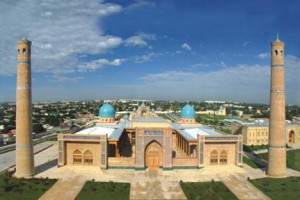SHARE WITH FRIENDS:
After the independence of Uzbekistan, the cultural and historical heritage of our ancestors has become more important, and historical monuments have been taken under state control. During the years of independence Bukhara, Samarkand, Termez, Khiva, Tashkent. Kokand. Monuments built with the high talent of our great ancestors in cities such as Shakhrisabz have found their true value, and their restoration and restoration has become one of the priorities of state policy.
Our history, monuments, and even monuments whose names have been forgotten have been repaired and restored. Memorial complexes worthy of the honor of such great scholars as Imam al-Bukhari, Imam at-Termizi, Abu Mansur al-Moturudi, Ahmad al-Fargani, Burhaniddin al-Marghinani, Mahmud az-Zamahshari have been created. Statues of Sahibkiran Amir Temur were erected in Tashkent, Samarkand and Shakhrisabz, Mirzo Ulugbek and Alisher Navoi in Tashkent, Jaloliddin Manguberdi in Urgench and Alpomish in Termez.
Today, more than seven thousand monuments, including 2500 architectural monuments, more than 2700 monumental works of art are under state protection in our country. Since 1991, the monuments in the Ichonkala Nature Reserve in Khiva, since 1993 in the center of Bukhara, in 2000 in the center of Shakhrisabz have been included in the UNESCO World Heritage List.
Akmasjid, one of the sacred places restored during the years of independence, is located in Khatirchi district of Navoi region. This mosque was built by one of the great men, Sayyid ota. According to the elders, the Oqmasjid, built in 1380-1390, became a sacred shrine of our people during the period of independence, dedicated to goodness and kindness, peace and tranquility. It serves to be in harmony and harmony with each other.
> The mosque was a favorite place of Muslims until the 1920s. In this mosque, teachers and clerics who graduated from Bukhara madrassas taught, taught the worshipers the ways of Sharia and the teachings, called them to honesty and purity, peace and tranquility. However, after the beginning of the dictatorial Soviet regime, mullahs and worshipers were persecuted. Mosques were closed. Our people, who were accused of being "listeners", "enemies of the people", "priests" and "oppressors", refrained from going to mosques. During the war, Akmasjid, like other mosques, was turned into a warehouse. Both the tombs of Sayyid Ata and the mosque were left unattended. Around the 1980s, worshipers came and went to the mosque for fear of communist ideological politicians. On September 1981, 1, the Sheikh Gadoy Selkin Mosque in the district center was allowed to operate. Including Oqmasjid.
After that, the clergy and worshipers organized a hashar and immediately began the beautification work. On September 2003, 5, the opening ceremony of the Oqmasjid was held. The mosque resumed operations.
Today, this mosque, which adorns the Khatirchi district with its majestic appearance, invites people to goodness and creates conditions for worshipers.
Preservation of our past, respect for historical monuments, relics, as well as the great past of our people, the social life in which they live and the future are directly related. These features are the national values of our nation and people, which have long been ingrained in their blood.
DURDONA INSTRUMENTS IN THE MONUMENTS OF UZBEKISTAN
More than four thousand material and spiritual monuments existing in the territory of our country are included in the UNESCO list as a unique example of the world heritage.
The oldest inscriptions and inscriptions created by the thinking and genius of our ancestors are our great spiritual wealth, from the folklore to the thousands of manuscripts kept in the treasury of our libraries today. A nation with such a great heritage is rare in the world.
President of the Republic of Uzbekistan Islam Karimov
